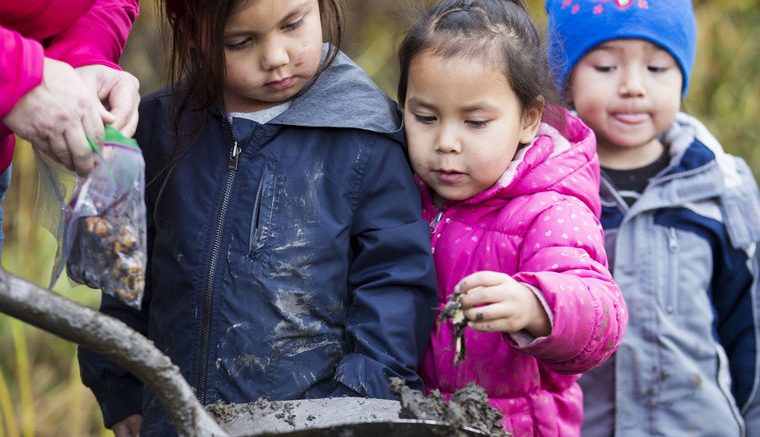HEYBURN STATE PARK — Already in a 4-year-old’s paradise — mud — Nikye Carillo spotted a water potato that had been dug up from the southern end of Lake Coeur d’Alene and his eyes widened.
“Whoaa,” the student at the Coeur d’Alene Tribe’s Early Childhood Learning Center said on Monday as he added the golf-ball-sized purple potato to his bag to take home.
Harvesting water potatoes, which are dried and used in stews or simply eaten raw, is a fall tradition for the Coeur d’Alene Tribe, one on which tribal members and others provide area students a hands-on lesson.
Starchy-tasting water potatoes are a natural- growing wetland plant with arrow-shaped leaves that rise above the water. Ducks and waterfowl eat the seeds, while muskrat, porcupine and deer also eat the tubers.
“The water potato is very special because it’s one of the traditional foods that we eat and harvest,” said Mark H. Stanger, a tribal elder and cultural advisor. “We save them for special feasts. To me, it’s a blessing to carry on the tradition for kids. If we don’t do this, it will be a loss. The kids really dig our festivities.”
The Tribe is educating about 500 students from throughout the region this week through Thursday on water potatoes, aquatic invasive species, culture, language, traditional tools and other topics at Hawley’s Landing at Heyburn State Park.
“The Tribe has been digging water potatoes since time immemorial, but we started to educate the students 16 years ago,” Stanger said. “We try to preserve water potatoes for as long as we can through the winter.”
While the potato harvesters used shovels to search, especially since recent rain made the water deeper than usual, the traditional way tribal women searched was with their bare feet. Often in icy water, women would find the potatoes in the mud with their feet and pick them with their toes.
Spring harvest for the Tribe consisted of camas, bitterroot, wild onion and carrots; summer included berries and fall water potatoes. The southern end of the lake served as a gathering place for tribes.
This year’s water potato harvest is bittersweet with last month’s passing of 93-year-old elder Felix Aripa, one of the last remaining fluent speakers of the Coeur d’Alene language and a regular at the fall harvests.
“His spirit is still here,” Stanger said. “Felix was a mentor who would come down and tell stories of the harvest.”
Meanwhile, Michael George, a Coeur d’Alene tribal member, is displaying a teepee at the cultural event, made from a wetland plant called tule.
“Tule was used to make teepees before canvas or hides,” George said, adding it took about three hours to make the teepee.
Glen Lambert, a fisheries technician with the U.S. Fish and Wildlife Service, cooked up strips of elk steak over cottonwood and red fir.
“It’s all about preserving this time of year,” he said. “It really helped the old-timers during the winter, so they didn’t have to hunt at that time. Fall was the time of gathering and laughing.”
Originally posted at Coeur d’Alene Press

